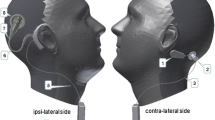Abstract
The probability of system failures increases as the number of cochlear implants increases throughout the world. Whether a malfunction is a technical or physiological problem remains to be defined, particularly in very young children, while a psychogenic hearing disorder after implantation must not be excluded in adults. The battery of objective measurements used clinically at the Medizinische Hochschule, Hannover has provided useful diagnostic information for distinguishing possible causes of failure. In a normally functioning device, an electrical signal equivalent to the biphasic rectangular stimulation pulse can be recorded by measuring skin potentials from surface electrodes placed on the mastoid of the implant side and the forehead. The signal from the stimulated implanted electrodes is derived by applying a constant pulse rate. Signal averaging is not necessary. If no signals are observed, a non-functioning device should be suspected. If the device works normally, function of the auditory pathways can be examined by recording the electrically elicited stapedius reflex or electrically evoked brain-stem responses. In our experience with more than 450 cochlear implant patients, eight internal device failures occurred, while an additional three patients had either reduced or no hearing sensations due to a disorder of the auditory pathways.
Similar content being viewed by others
References
Battmer RD, Laszig R, Lehnhardt E (1990) Electrically elicited stapedius reflex in cochlear implant patients. Ear Hear 11: 370–374
Battmer RD, Lehnhardt E, Gnadeberg D (1990) Intraoperativ elektrisch ausgeloste Stapediusreflexe and ihre Bedeutung zur Anpassung beim Cochlear-Implant. Arch Otorhinolaryngol 2[Suppl]: 152–154
Author information
Authors and Affiliations
Additional information
Reported in part at the 63rd Meeting of the German Society of Oto-Rhino-Laryngology and Head and Neck Surgery in Garmisch-Partenkirchen, 1992
Rights and permissions
About this article
Cite this article
Battmer, RD., Gnadeberg, D., Lehnhardt, E. et al. An integrity test battery for the nucleus mini 22 cochlear implant system. Eur Arch Otorhinolaryngol 251, 205–209 (1994). https://doi.org/10.1007/BF00628424
Received:
Accepted:
Issue Date:
DOI: https://doi.org/10.1007/BF00628424




